Medicinal Errors Report: Analysis of Healthcare Incidents and Policies
VerifiedAdded on 2022/09/29
|17
|4218
|28
Report
AI Summary
This report provides a comprehensive analysis of medicinal errors within healthcare settings. It begins with an executive summary highlighting the prevalence and impact of such errors, especially in relation to patient safety, particularly in the context of the Royal Children's Hospital in Australia. The report delves into the causes and influencing factors of medicinal errors, including those related to healthcare professionals (lack of training, overwork), patients (language barriers, complex conditions), work environments (workload, distractions), medicine-related factors (labeling, packaging), and computerized information systems. It examines reporting mechanisms, relevant policies and standards, such as the National Safety and Quality Health Service (NSQHS) Standards, and the investigation of a specific medical incident. The report details the importance of systematic review and reporting to prevent future errors and improve patient outcomes. It concludes with recommendations and a remedial quality improvement plan, focusing on consumer-centered care, data-driven strategies, and organized safety measures. The report emphasizes the need for better communication, improved documentation, and proactive measures to minimize medication-related risks and enhance the overall quality of healthcare delivery.
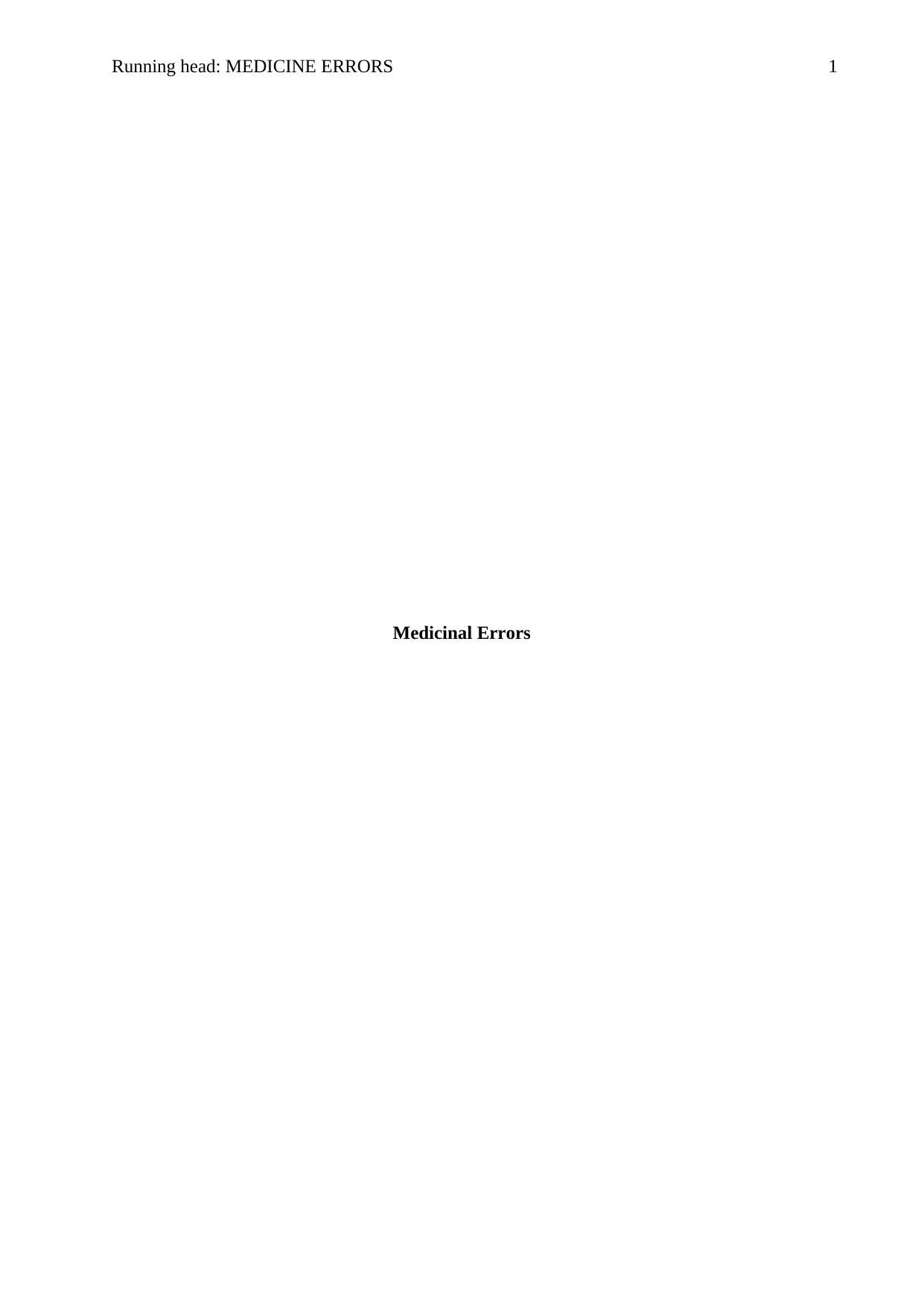
Running head: MEDICINE ERRORS 1
Medicinal Errors
Medicinal Errors
Paraphrase This Document
Need a fresh take? Get an instant paraphrase of this document with our AI Paraphraser
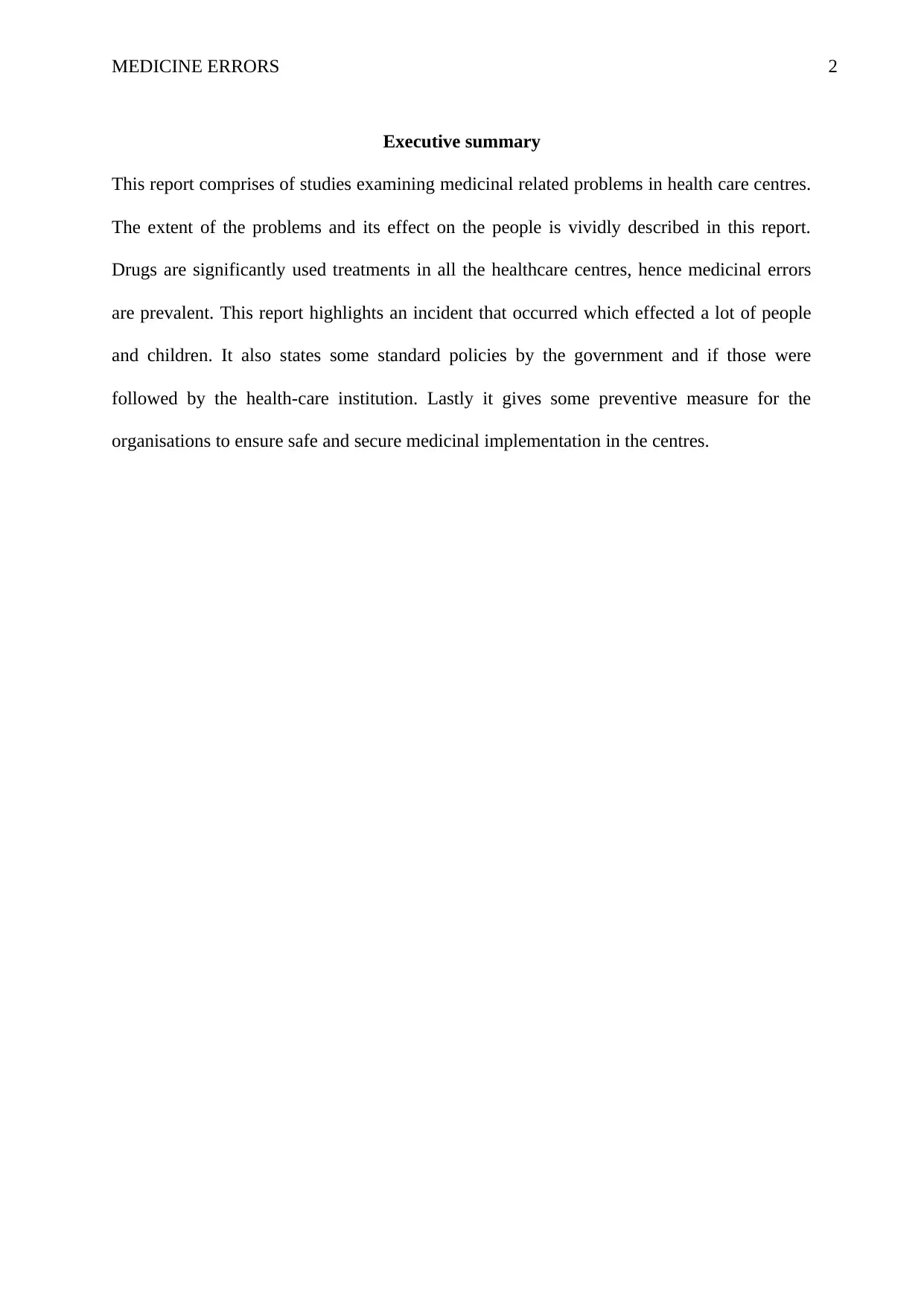
MEDICINE ERRORS 2
Executive summary
This report comprises of studies examining medicinal related problems in health care centres.
The extent of the problems and its effect on the people is vividly described in this report.
Drugs are significantly used treatments in all the healthcare centres, hence medicinal errors
are prevalent. This report highlights an incident that occurred which effected a lot of people
and children. It also states some standard policies by the government and if those were
followed by the health-care institution. Lastly it gives some preventive measure for the
organisations to ensure safe and secure medicinal implementation in the centres.
Executive summary
This report comprises of studies examining medicinal related problems in health care centres.
The extent of the problems and its effect on the people is vividly described in this report.
Drugs are significantly used treatments in all the healthcare centres, hence medicinal errors
are prevalent. This report highlights an incident that occurred which effected a lot of people
and children. It also states some standard policies by the government and if those were
followed by the health-care institution. Lastly it gives some preventive measure for the
organisations to ensure safe and secure medicinal implementation in the centres.
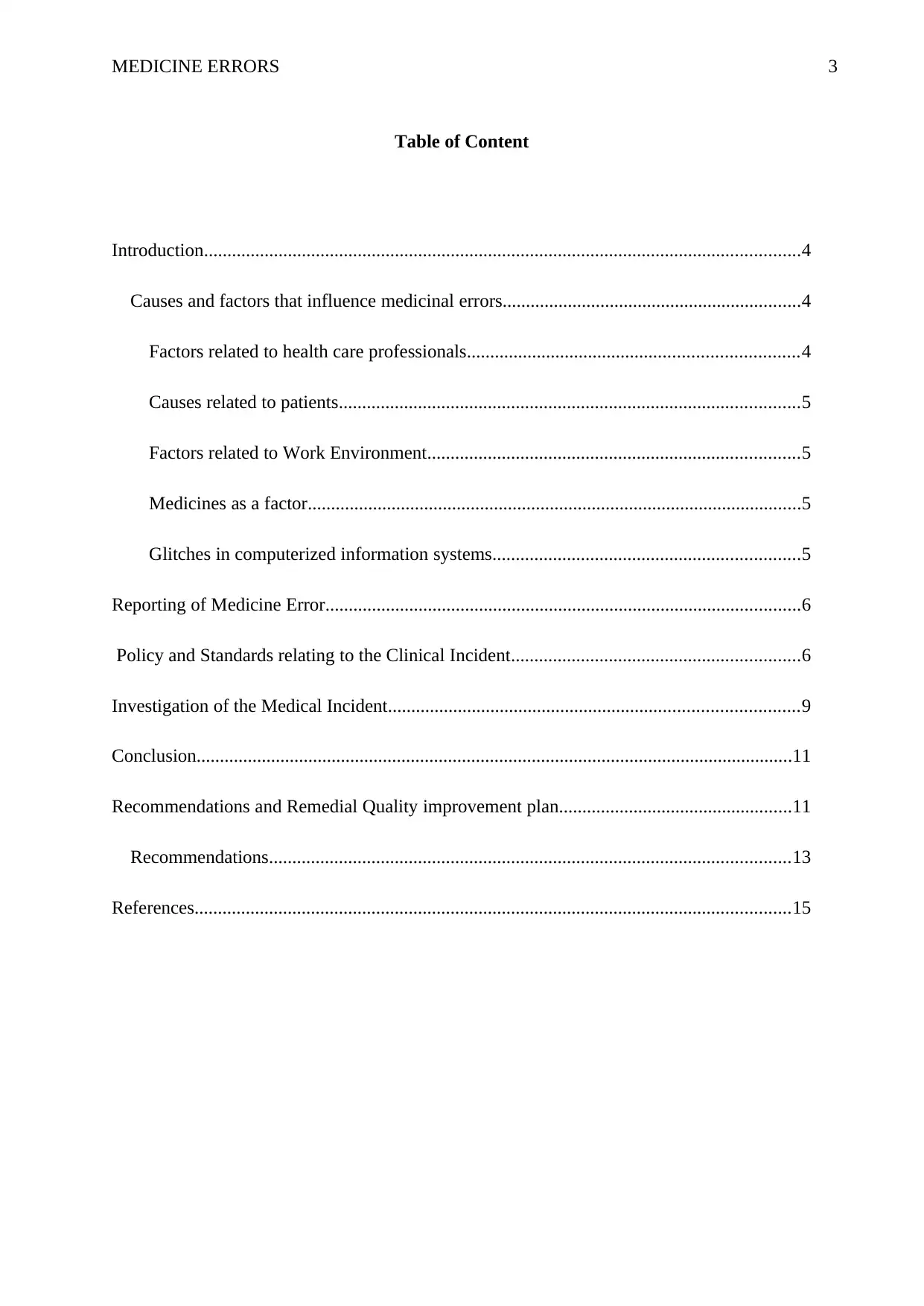
MEDICINE ERRORS 3
Table of Content
Introduction................................................................................................................................4
Causes and factors that influence medicinal errors................................................................4
Factors related to health care professionals.......................................................................4
Causes related to patients...................................................................................................5
Factors related to Work Environment................................................................................5
Medicines as a factor..........................................................................................................5
Glitches in computerized information systems..................................................................5
Reporting of Medicine Error......................................................................................................6
Policy and Standards relating to the Clinical Incident..............................................................6
Investigation of the Medical Incident........................................................................................9
Conclusion................................................................................................................................11
Recommendations and Remedial Quality improvement plan..................................................11
Recommendations................................................................................................................13
References................................................................................................................................15
Table of Content
Introduction................................................................................................................................4
Causes and factors that influence medicinal errors................................................................4
Factors related to health care professionals.......................................................................4
Causes related to patients...................................................................................................5
Factors related to Work Environment................................................................................5
Medicines as a factor..........................................................................................................5
Glitches in computerized information systems..................................................................5
Reporting of Medicine Error......................................................................................................6
Policy and Standards relating to the Clinical Incident..............................................................6
Investigation of the Medical Incident........................................................................................9
Conclusion................................................................................................................................11
Recommendations and Remedial Quality improvement plan..................................................11
Recommendations................................................................................................................13
References................................................................................................................................15
⊘ This is a preview!⊘
Do you want full access?
Subscribe today to unlock all pages.

Trusted by 1+ million students worldwide
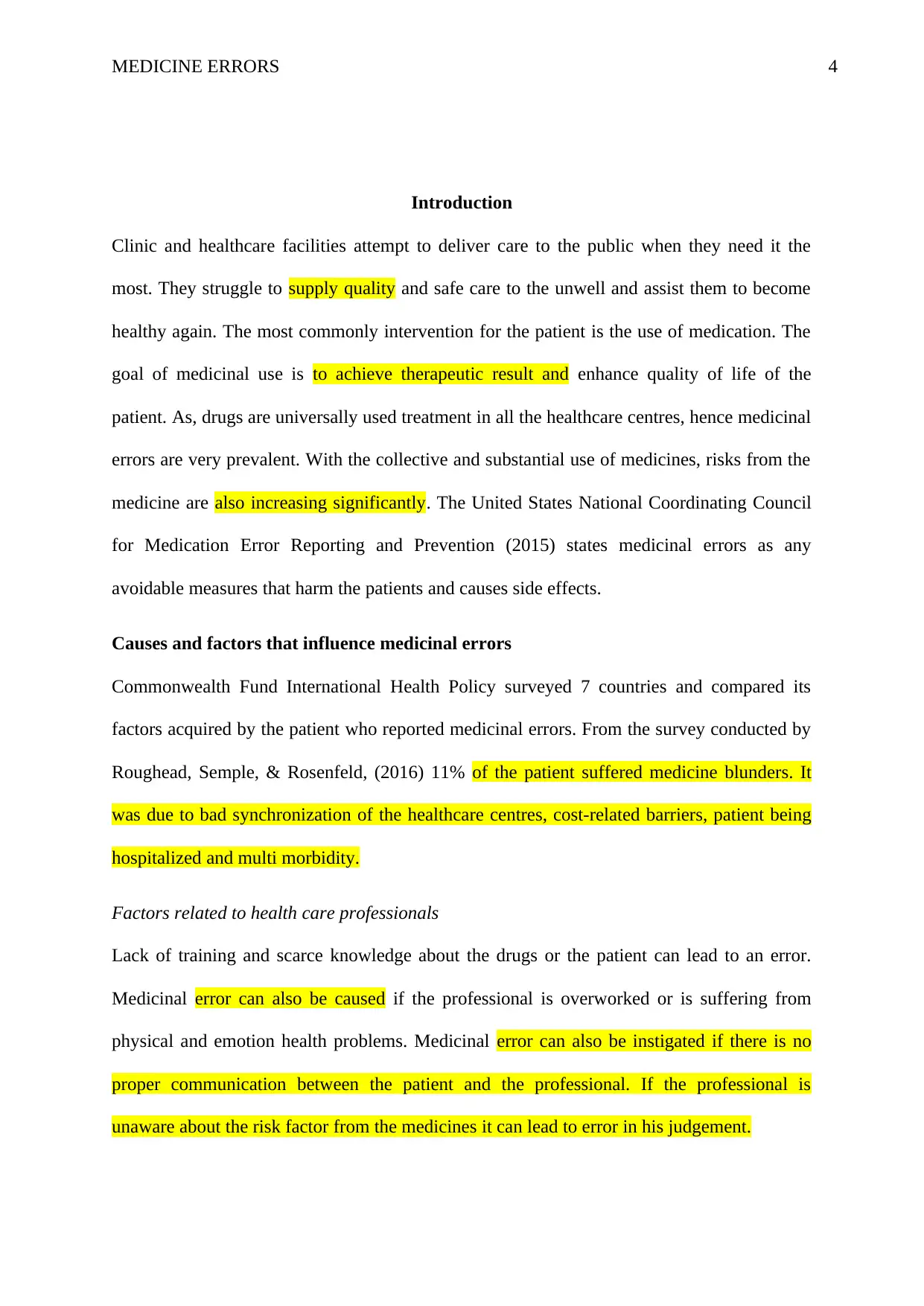
MEDICINE ERRORS 4
Introduction
Clinic and healthcare facilities attempt to deliver care to the public when they need it the
most. They struggle to supply quality and safe care to the unwell and assist them to become
healthy again. The most commonly intervention for the patient is the use of medication. The
goal of medicinal use is to achieve therapeutic result and enhance quality of life of the
patient. As, drugs are universally used treatment in all the healthcare centres, hence medicinal
errors are very prevalent. With the collective and substantial use of medicines, risks from the
medicine are also increasing significantly. The United States National Coordinating Council
for Medication Error Reporting and Prevention (2015) states medicinal errors as any
avoidable measures that harm the patients and causes side effects.
Causes and factors that influence medicinal errors
Commonwealth Fund International Health Policy surveyed 7 countries and compared its
factors acquired by the patient who reported medicinal errors. From the survey conducted by
Roughead, Semple, & Rosenfeld, (2016) 11% of the patient suffered medicine blunders. It
was due to bad synchronization of the healthcare centres, cost-related barriers, patient being
hospitalized and multi morbidity.
Factors related to health care professionals
Lack of training and scarce knowledge about the drugs or the patient can lead to an error.
Medicinal error can also be caused if the professional is overworked or is suffering from
physical and emotion health problems. Medicinal error can also be instigated if there is no
proper communication between the patient and the professional. If the professional is
unaware about the risk factor from the medicines it can lead to error in his judgement.
Introduction
Clinic and healthcare facilities attempt to deliver care to the public when they need it the
most. They struggle to supply quality and safe care to the unwell and assist them to become
healthy again. The most commonly intervention for the patient is the use of medication. The
goal of medicinal use is to achieve therapeutic result and enhance quality of life of the
patient. As, drugs are universally used treatment in all the healthcare centres, hence medicinal
errors are very prevalent. With the collective and substantial use of medicines, risks from the
medicine are also increasing significantly. The United States National Coordinating Council
for Medication Error Reporting and Prevention (2015) states medicinal errors as any
avoidable measures that harm the patients and causes side effects.
Causes and factors that influence medicinal errors
Commonwealth Fund International Health Policy surveyed 7 countries and compared its
factors acquired by the patient who reported medicinal errors. From the survey conducted by
Roughead, Semple, & Rosenfeld, (2016) 11% of the patient suffered medicine blunders. It
was due to bad synchronization of the healthcare centres, cost-related barriers, patient being
hospitalized and multi morbidity.
Factors related to health care professionals
Lack of training and scarce knowledge about the drugs or the patient can lead to an error.
Medicinal error can also be caused if the professional is overworked or is suffering from
physical and emotion health problems. Medicinal error can also be instigated if there is no
proper communication between the patient and the professional. If the professional is
unaware about the risk factor from the medicines it can lead to error in his judgement.
Paraphrase This Document
Need a fresh take? Get an instant paraphrase of this document with our AI Paraphraser
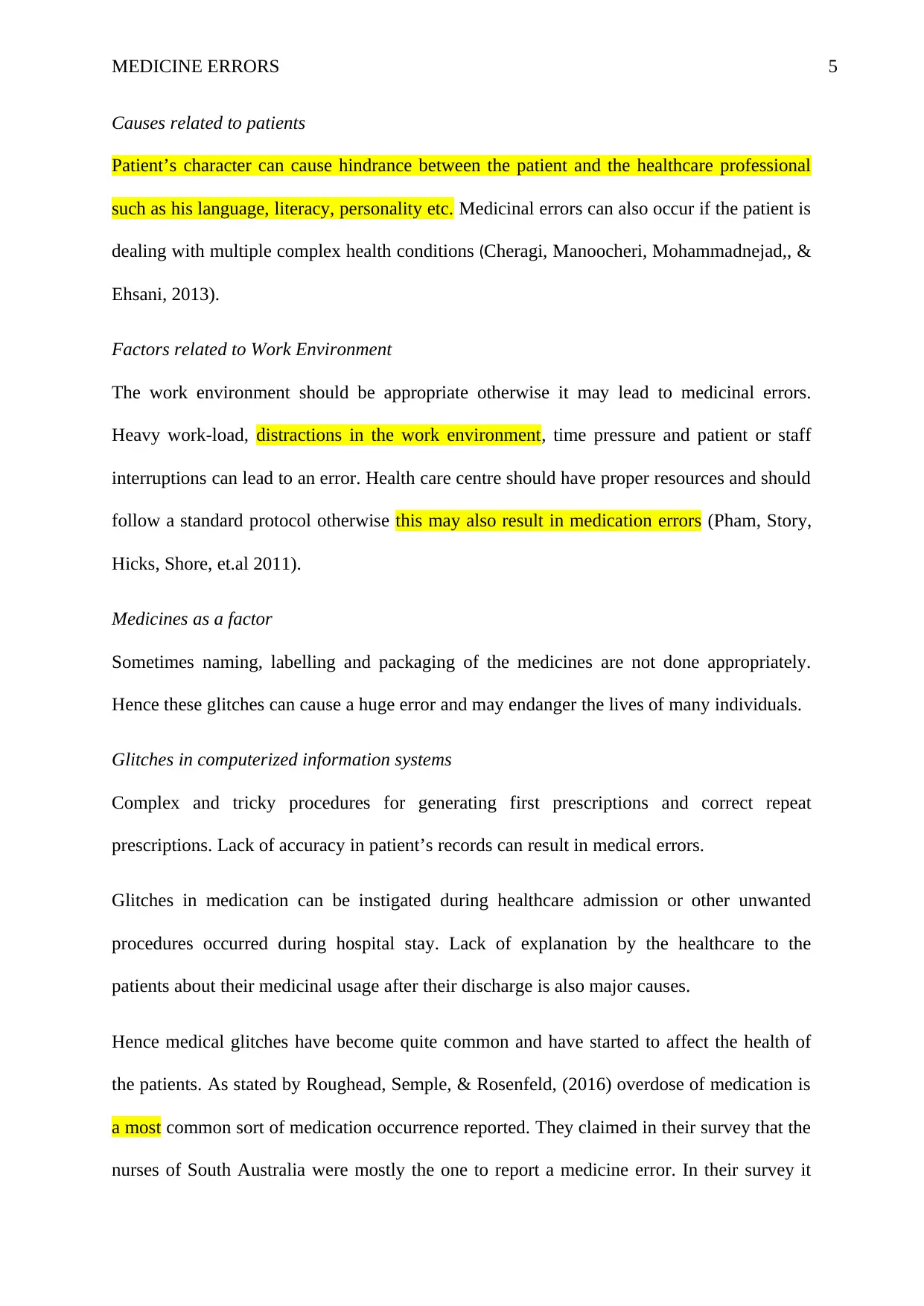
MEDICINE ERRORS 5
Causes related to patients
Patient’s character can cause hindrance between the patient and the healthcare professional
such as his language, literacy, personality etc. Medicinal errors can also occur if the patient is
dealing with multiple complex health conditions (Cheragi, Manoocheri, Mohammadnejad,, &
Ehsani, 2013).
Factors related to Work Environment
The work environment should be appropriate otherwise it may lead to medicinal errors.
Heavy work-load, distractions in the work environment, time pressure and patient or staff
interruptions can lead to an error. Health care centre should have proper resources and should
follow a standard protocol otherwise this may also result in medication errors (Pham, Story,
Hicks, Shore, et.al 2011).
Medicines as a factor
Sometimes naming, labelling and packaging of the medicines are not done appropriately.
Hence these glitches can cause a huge error and may endanger the lives of many individuals.
Glitches in computerized information systems
Complex and tricky procedures for generating first prescriptions and correct repeat
prescriptions. Lack of accuracy in patient’s records can result in medical errors.
Glitches in medication can be instigated during healthcare admission or other unwanted
procedures occurred during hospital stay. Lack of explanation by the healthcare to the
patients about their medicinal usage after their discharge is also major causes.
Hence medical glitches have become quite common and have started to affect the health of
the patients. As stated by Roughead, Semple, & Rosenfeld, (2016) overdose of medication is
a most common sort of medication occurrence reported. They claimed in their survey that the
nurses of South Australia were mostly the one to report a medicine error. In their survey it
Causes related to patients
Patient’s character can cause hindrance between the patient and the healthcare professional
such as his language, literacy, personality etc. Medicinal errors can also occur if the patient is
dealing with multiple complex health conditions (Cheragi, Manoocheri, Mohammadnejad,, &
Ehsani, 2013).
Factors related to Work Environment
The work environment should be appropriate otherwise it may lead to medicinal errors.
Heavy work-load, distractions in the work environment, time pressure and patient or staff
interruptions can lead to an error. Health care centre should have proper resources and should
follow a standard protocol otherwise this may also result in medication errors (Pham, Story,
Hicks, Shore, et.al 2011).
Medicines as a factor
Sometimes naming, labelling and packaging of the medicines are not done appropriately.
Hence these glitches can cause a huge error and may endanger the lives of many individuals.
Glitches in computerized information systems
Complex and tricky procedures for generating first prescriptions and correct repeat
prescriptions. Lack of accuracy in patient’s records can result in medical errors.
Glitches in medication can be instigated during healthcare admission or other unwanted
procedures occurred during hospital stay. Lack of explanation by the healthcare to the
patients about their medicinal usage after their discharge is also major causes.
Hence medical glitches have become quite common and have started to affect the health of
the patients. As stated by Roughead, Semple, & Rosenfeld, (2016) overdose of medication is
a most common sort of medication occurrence reported. They claimed in their survey that the
nurses of South Australia were mostly the one to report a medicine error. In their survey it
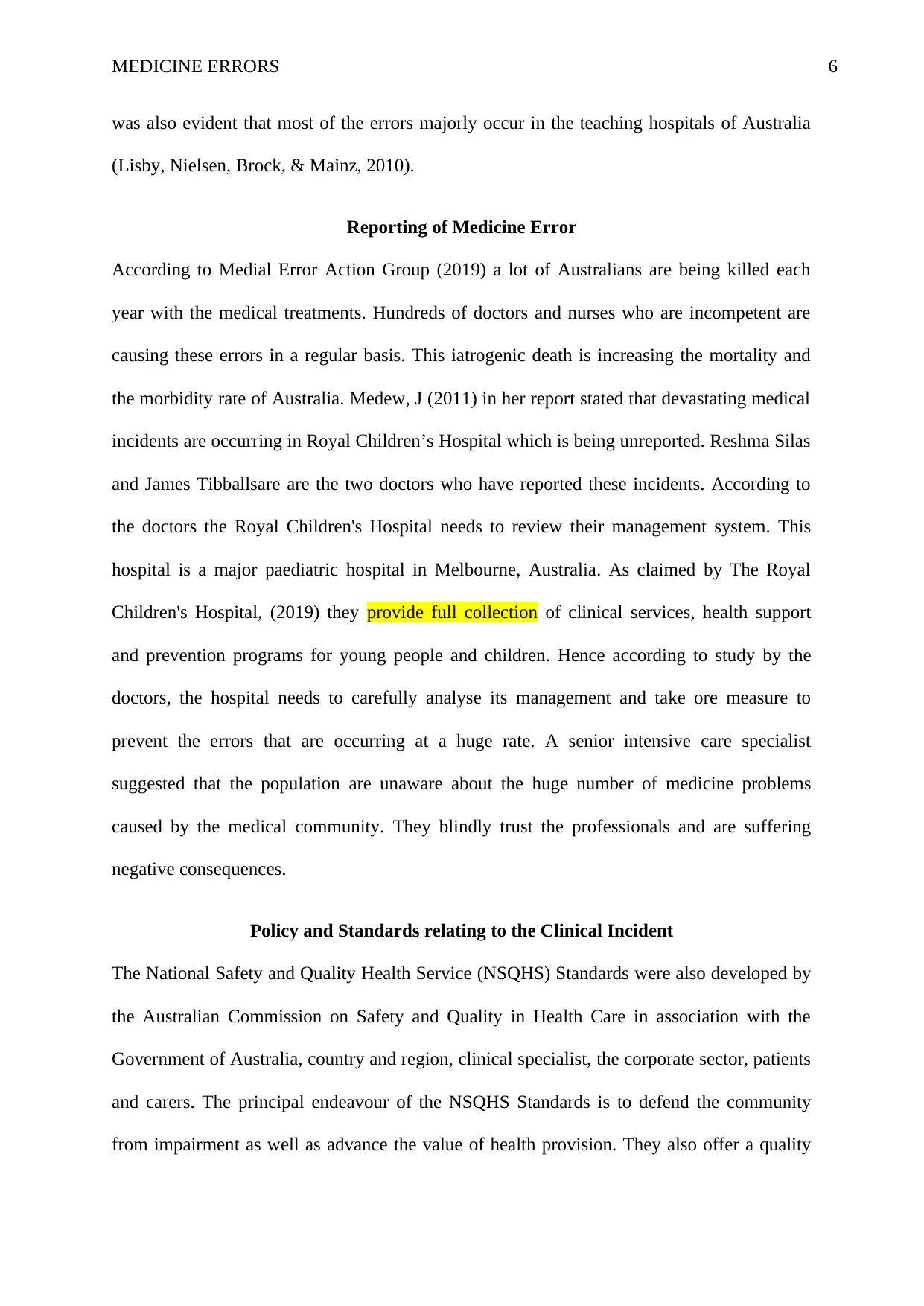
MEDICINE ERRORS 6
was also evident that most of the errors majorly occur in the teaching hospitals of Australia
(Lisby, Nielsen, Brock, & Mainz, 2010).
Reporting of Medicine Error
According to Medial Error Action Group (2019) a lot of Australians are being killed each
year with the medical treatments. Hundreds of doctors and nurses who are incompetent are
causing these errors in a regular basis. This iatrogenic death is increasing the mortality and
the morbidity rate of Australia. Medew, J (2011) in her report stated that devastating medical
incidents are occurring in Royal Children’s Hospital which is being unreported. Reshma Silas
and James Tibballsare are the two doctors who have reported these incidents. According to
the doctors the Royal Children's Hospital needs to review their management system. This
hospital is a major paediatric hospital in Melbourne, Australia. As claimed by The Royal
Children's Hospital, (2019) they provide full collection of clinical services, health support
and prevention programs for young people and children. Hence according to study by the
doctors, the hospital needs to carefully analyse its management and take ore measure to
prevent the errors that are occurring at a huge rate. A senior intensive care specialist
suggested that the population are unaware about the huge number of medicine problems
caused by the medical community. They blindly trust the professionals and are suffering
negative consequences.
Policy and Standards relating to the Clinical Incident
The National Safety and Quality Health Service (NSQHS) Standards were also developed by
the Australian Commission on Safety and Quality in Health Care in association with the
Government of Australia, country and region, clinical specialist, the corporate sector, patients
and carers. The principal endeavour of the NSQHS Standards is to defend the community
from impairment as well as advance the value of health provision. They also offer a quality
was also evident that most of the errors majorly occur in the teaching hospitals of Australia
(Lisby, Nielsen, Brock, & Mainz, 2010).
Reporting of Medicine Error
According to Medial Error Action Group (2019) a lot of Australians are being killed each
year with the medical treatments. Hundreds of doctors and nurses who are incompetent are
causing these errors in a regular basis. This iatrogenic death is increasing the mortality and
the morbidity rate of Australia. Medew, J (2011) in her report stated that devastating medical
incidents are occurring in Royal Children’s Hospital which is being unreported. Reshma Silas
and James Tibballsare are the two doctors who have reported these incidents. According to
the doctors the Royal Children's Hospital needs to review their management system. This
hospital is a major paediatric hospital in Melbourne, Australia. As claimed by The Royal
Children's Hospital, (2019) they provide full collection of clinical services, health support
and prevention programs for young people and children. Hence according to study by the
doctors, the hospital needs to carefully analyse its management and take ore measure to
prevent the errors that are occurring at a huge rate. A senior intensive care specialist
suggested that the population are unaware about the huge number of medicine problems
caused by the medical community. They blindly trust the professionals and are suffering
negative consequences.
Policy and Standards relating to the Clinical Incident
The National Safety and Quality Health Service (NSQHS) Standards were also developed by
the Australian Commission on Safety and Quality in Health Care in association with the
Government of Australia, country and region, clinical specialist, the corporate sector, patients
and carers. The principal endeavour of the NSQHS Standards is to defend the community
from impairment as well as advance the value of health provision. They also offer a quality
⊘ This is a preview!⊘
Do you want full access?
Subscribe today to unlock all pages.

Trusted by 1+ million students worldwide
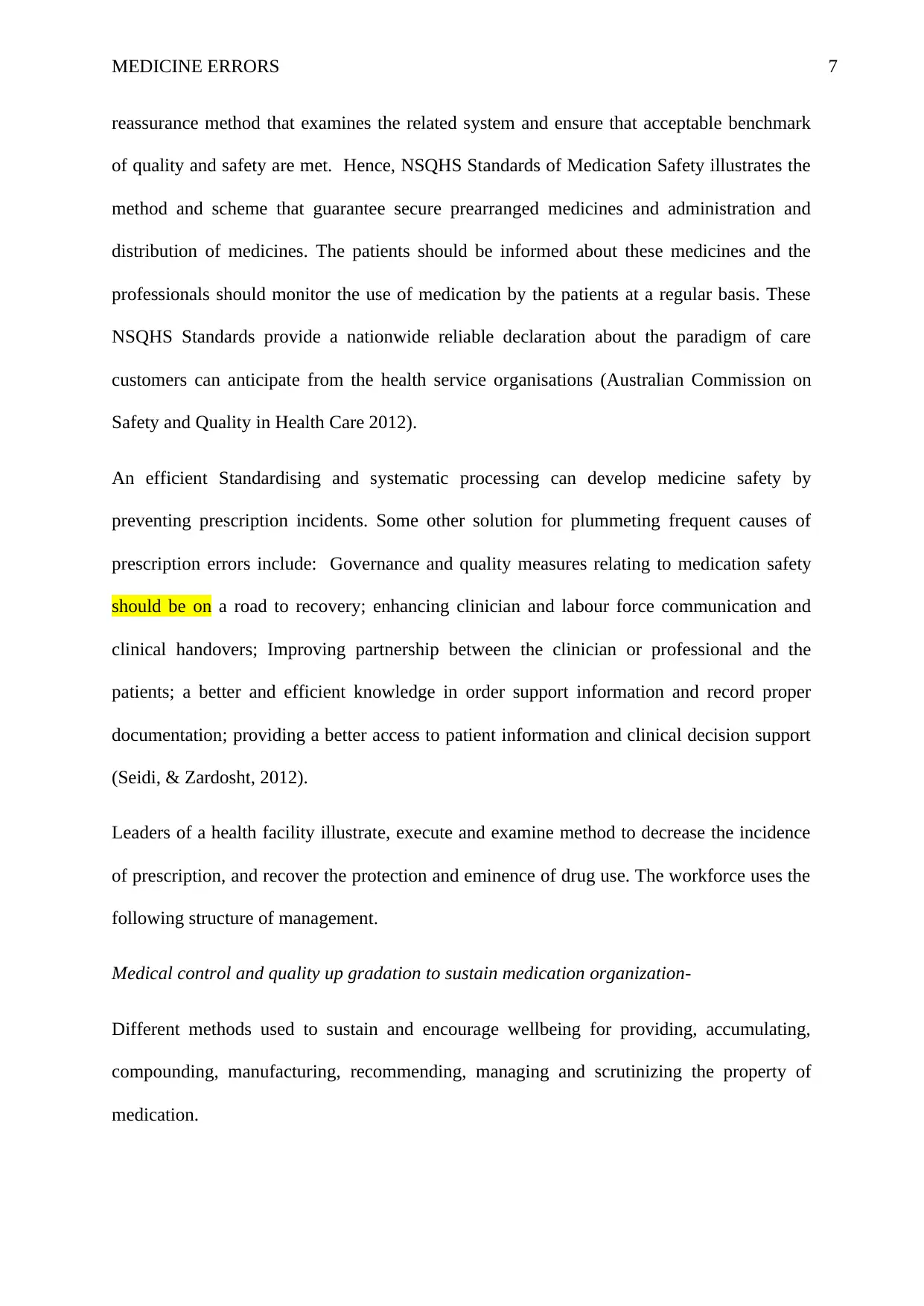
MEDICINE ERRORS 7
reassurance method that examines the related system and ensure that acceptable benchmark
of quality and safety are met. Hence, NSQHS Standards of Medication Safety illustrates the
method and scheme that guarantee secure prearranged medicines and administration and
distribution of medicines. The patients should be informed about these medicines and the
professionals should monitor the use of medication by the patients at a regular basis. These
NSQHS Standards provide a nationwide reliable declaration about the paradigm of care
customers can anticipate from the health service organisations (Australian Commission on
Safety and Quality in Health Care 2012).
An efficient Standardising and systematic processing can develop medicine safety by
preventing prescription incidents. Some other solution for plummeting frequent causes of
prescription errors include: Governance and quality measures relating to medication safety
should be on a road to recovery; enhancing clinician and labour force communication and
clinical handovers; Improving partnership between the clinician or professional and the
patients; a better and efficient knowledge in order support information and record proper
documentation; providing a better access to patient information and clinical decision support
(Seidi, & Zardosht, 2012).
Leaders of a health facility illustrate, execute and examine method to decrease the incidence
of prescription, and recover the protection and eminence of drug use. The workforce uses the
following structure of management.
Medical control and quality up gradation to sustain medication organization-
Different methods used to sustain and encourage wellbeing for providing, accumulating,
compounding, manufacturing, recommending, managing and scrutinizing the property of
medication.
reassurance method that examines the related system and ensure that acceptable benchmark
of quality and safety are met. Hence, NSQHS Standards of Medication Safety illustrates the
method and scheme that guarantee secure prearranged medicines and administration and
distribution of medicines. The patients should be informed about these medicines and the
professionals should monitor the use of medication by the patients at a regular basis. These
NSQHS Standards provide a nationwide reliable declaration about the paradigm of care
customers can anticipate from the health service organisations (Australian Commission on
Safety and Quality in Health Care 2012).
An efficient Standardising and systematic processing can develop medicine safety by
preventing prescription incidents. Some other solution for plummeting frequent causes of
prescription errors include: Governance and quality measures relating to medication safety
should be on a road to recovery; enhancing clinician and labour force communication and
clinical handovers; Improving partnership between the clinician or professional and the
patients; a better and efficient knowledge in order support information and record proper
documentation; providing a better access to patient information and clinical decision support
(Seidi, & Zardosht, 2012).
Leaders of a health facility illustrate, execute and examine method to decrease the incidence
of prescription, and recover the protection and eminence of drug use. The workforce uses the
following structure of management.
Medical control and quality up gradation to sustain medication organization-
Different methods used to sustain and encourage wellbeing for providing, accumulating,
compounding, manufacturing, recommending, managing and scrutinizing the property of
medication.
Paraphrase This Document
Need a fresh take? Get an instant paraphrase of this document with our AI Paraphraser
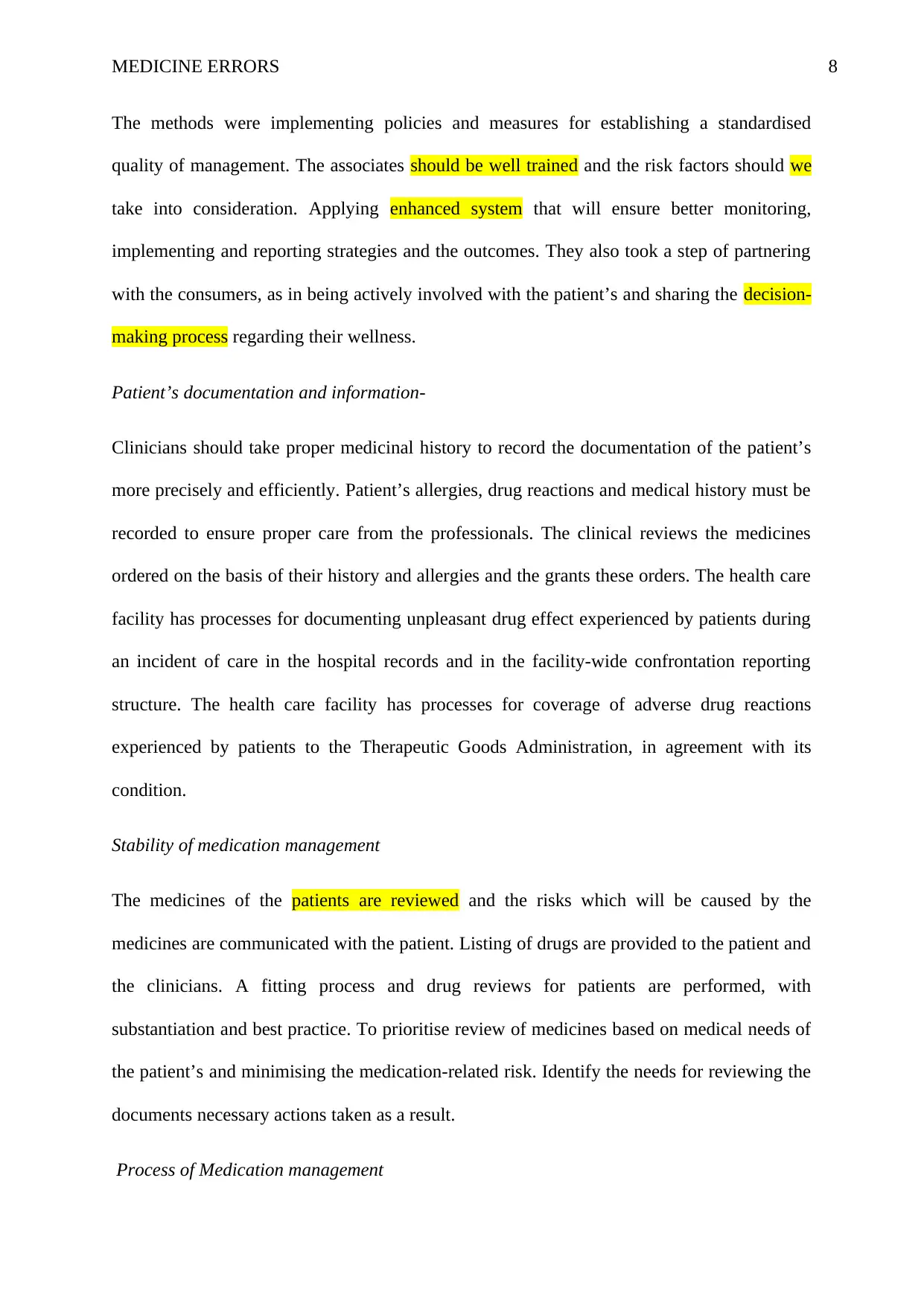
MEDICINE ERRORS 8
The methods were implementing policies and measures for establishing a standardised
quality of management. The associates should be well trained and the risk factors should we
take into consideration. Applying enhanced system that will ensure better monitoring,
implementing and reporting strategies and the outcomes. They also took a step of partnering
with the consumers, as in being actively involved with the patient’s and sharing the decision-
making process regarding their wellness.
Patient’s documentation and information-
Clinicians should take proper medicinal history to record the documentation of the patient’s
more precisely and efficiently. Patient’s allergies, drug reactions and medical history must be
recorded to ensure proper care from the professionals. The clinical reviews the medicines
ordered on the basis of their history and allergies and the grants these orders. The health care
facility has processes for documenting unpleasant drug effect experienced by patients during
an incident of care in the hospital records and in the facility-wide confrontation reporting
structure. The health care facility has processes for coverage of adverse drug reactions
experienced by patients to the Therapeutic Goods Administration, in agreement with its
condition.
Stability of medication management
The medicines of the patients are reviewed and the risks which will be caused by the
medicines are communicated with the patient. Listing of drugs are provided to the patient and
the clinicians. A fitting process and drug reviews for patients are performed, with
substantiation and best practice. To prioritise review of medicines based on medical needs of
the patient’s and minimising the medication-related risk. Identify the needs for reviewing the
documents necessary actions taken as a result.
Process of Medication management
The methods were implementing policies and measures for establishing a standardised
quality of management. The associates should be well trained and the risk factors should we
take into consideration. Applying enhanced system that will ensure better monitoring,
implementing and reporting strategies and the outcomes. They also took a step of partnering
with the consumers, as in being actively involved with the patient’s and sharing the decision-
making process regarding their wellness.
Patient’s documentation and information-
Clinicians should take proper medicinal history to record the documentation of the patient’s
more precisely and efficiently. Patient’s allergies, drug reactions and medical history must be
recorded to ensure proper care from the professionals. The clinical reviews the medicines
ordered on the basis of their history and allergies and the grants these orders. The health care
facility has processes for documenting unpleasant drug effect experienced by patients during
an incident of care in the hospital records and in the facility-wide confrontation reporting
structure. The health care facility has processes for coverage of adverse drug reactions
experienced by patients to the Therapeutic Goods Administration, in agreement with its
condition.
Stability of medication management
The medicines of the patients are reviewed and the risks which will be caused by the
medicines are communicated with the patient. Listing of drugs are provided to the patient and
the clinicians. A fitting process and drug reviews for patients are performed, with
substantiation and best practice. To prioritise review of medicines based on medical needs of
the patient’s and minimising the medication-related risk. Identify the needs for reviewing the
documents necessary actions taken as a result.
Process of Medication management
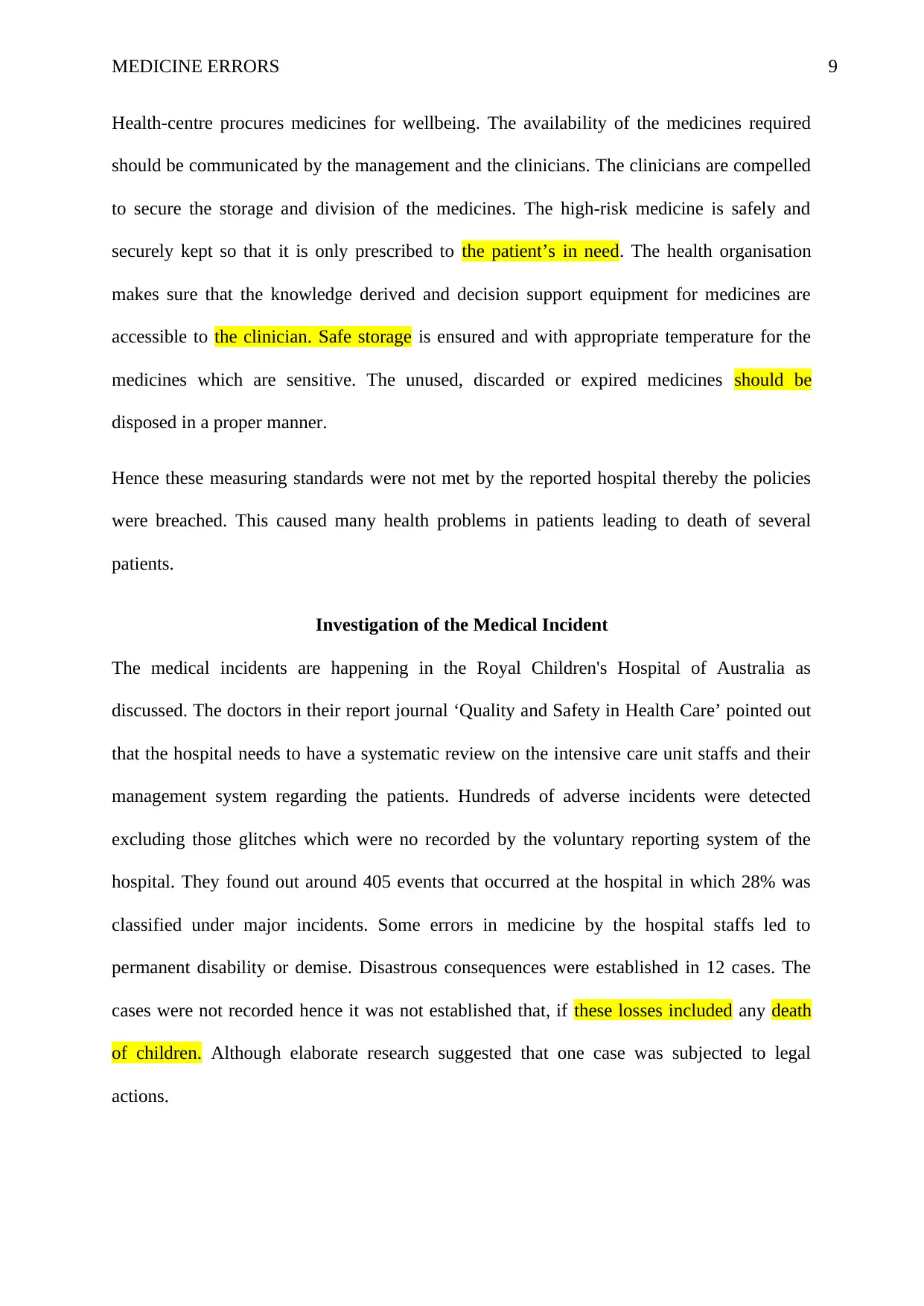
MEDICINE ERRORS 9
Health-centre procures medicines for wellbeing. The availability of the medicines required
should be communicated by the management and the clinicians. The clinicians are compelled
to secure the storage and division of the medicines. The high-risk medicine is safely and
securely kept so that it is only prescribed to the patient’s in need. The health organisation
makes sure that the knowledge derived and decision support equipment for medicines are
accessible to the clinician. Safe storage is ensured and with appropriate temperature for the
medicines which are sensitive. The unused, discarded or expired medicines should be
disposed in a proper manner.
Hence these measuring standards were not met by the reported hospital thereby the policies
were breached. This caused many health problems in patients leading to death of several
patients.
Investigation of the Medical Incident
The medical incidents are happening in the Royal Children's Hospital of Australia as
discussed. The doctors in their report journal ‘Quality and Safety in Health Care’ pointed out
that the hospital needs to have a systematic review on the intensive care unit staffs and their
management system regarding the patients. Hundreds of adverse incidents were detected
excluding those glitches which were no recorded by the voluntary reporting system of the
hospital. They found out around 405 events that occurred at the hospital in which 28% was
classified under major incidents. Some errors in medicine by the hospital staffs led to
permanent disability or demise. Disastrous consequences were established in 12 cases. The
cases were not recorded hence it was not established that, if these losses included any death
of children. Although elaborate research suggested that one case was subjected to legal
actions.
Health-centre procures medicines for wellbeing. The availability of the medicines required
should be communicated by the management and the clinicians. The clinicians are compelled
to secure the storage and division of the medicines. The high-risk medicine is safely and
securely kept so that it is only prescribed to the patient’s in need. The health organisation
makes sure that the knowledge derived and decision support equipment for medicines are
accessible to the clinician. Safe storage is ensured and with appropriate temperature for the
medicines which are sensitive. The unused, discarded or expired medicines should be
disposed in a proper manner.
Hence these measuring standards were not met by the reported hospital thereby the policies
were breached. This caused many health problems in patients leading to death of several
patients.
Investigation of the Medical Incident
The medical incidents are happening in the Royal Children's Hospital of Australia as
discussed. The doctors in their report journal ‘Quality and Safety in Health Care’ pointed out
that the hospital needs to have a systematic review on the intensive care unit staffs and their
management system regarding the patients. Hundreds of adverse incidents were detected
excluding those glitches which were no recorded by the voluntary reporting system of the
hospital. They found out around 405 events that occurred at the hospital in which 28% was
classified under major incidents. Some errors in medicine by the hospital staffs led to
permanent disability or demise. Disastrous consequences were established in 12 cases. The
cases were not recorded hence it was not established that, if these losses included any death
of children. Although elaborate research suggested that one case was subjected to legal
actions.
⊘ This is a preview!⊘
Do you want full access?
Subscribe today to unlock all pages.

Trusted by 1+ million students worldwide
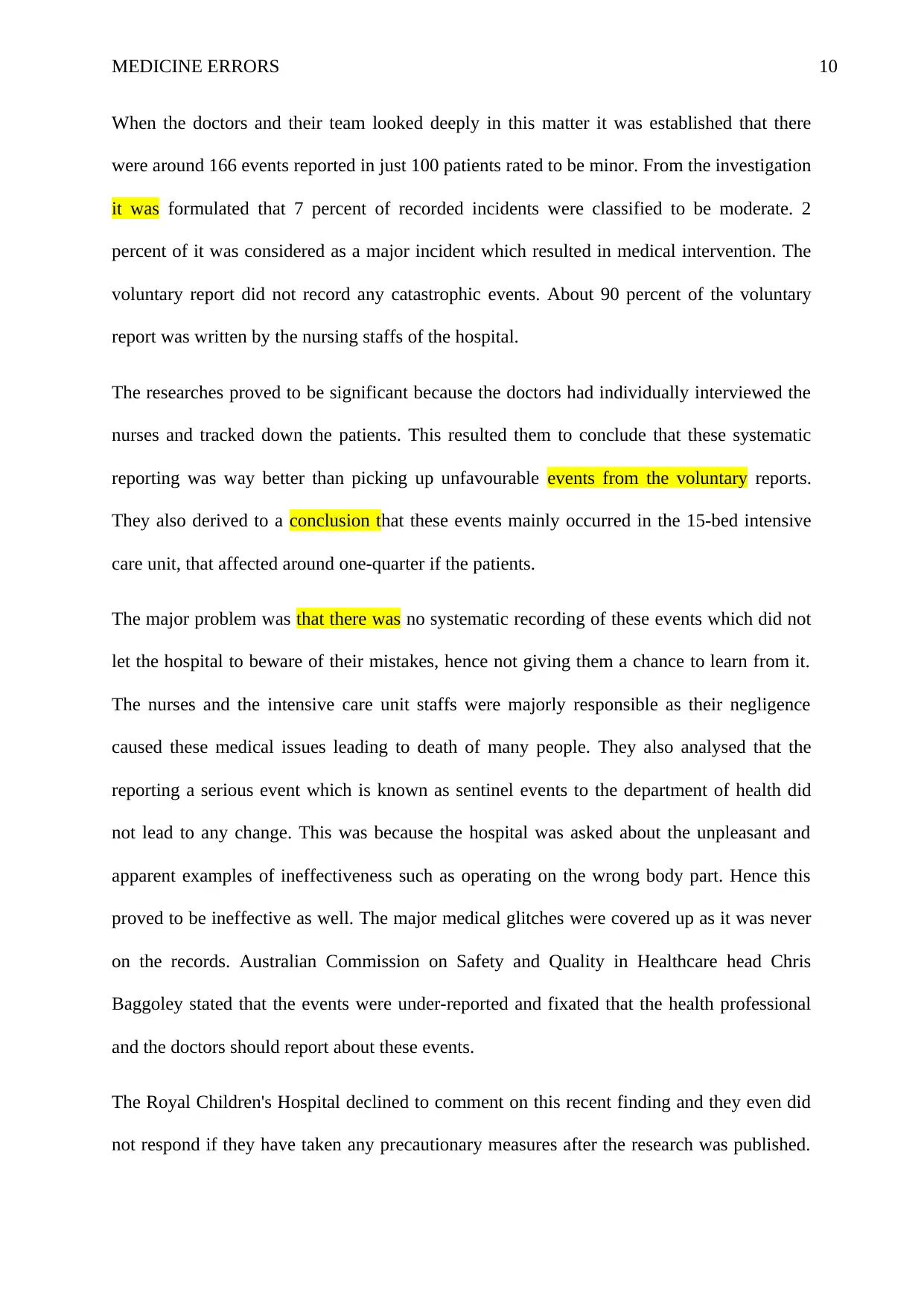
MEDICINE ERRORS 10
When the doctors and their team looked deeply in this matter it was established that there
were around 166 events reported in just 100 patients rated to be minor. From the investigation
it was formulated that 7 percent of recorded incidents were classified to be moderate. 2
percent of it was considered as a major incident which resulted in medical intervention. The
voluntary report did not record any catastrophic events. About 90 percent of the voluntary
report was written by the nursing staffs of the hospital.
The researches proved to be significant because the doctors had individually interviewed the
nurses and tracked down the patients. This resulted them to conclude that these systematic
reporting was way better than picking up unfavourable events from the voluntary reports.
They also derived to a conclusion that these events mainly occurred in the 15-bed intensive
care unit, that affected around one-quarter if the patients.
The major problem was that there was no systematic recording of these events which did not
let the hospital to beware of their mistakes, hence not giving them a chance to learn from it.
The nurses and the intensive care unit staffs were majorly responsible as their negligence
caused these medical issues leading to death of many people. They also analysed that the
reporting a serious event which is known as sentinel events to the department of health did
not lead to any change. This was because the hospital was asked about the unpleasant and
apparent examples of ineffectiveness such as operating on the wrong body part. Hence this
proved to be ineffective as well. The major medical glitches were covered up as it was never
on the records. Australian Commission on Safety and Quality in Healthcare head Chris
Baggoley stated that the events were under-reported and fixated that the health professional
and the doctors should report about these events.
The Royal Children's Hospital declined to comment on this recent finding and they even did
not respond if they have taken any precautionary measures after the research was published.
When the doctors and their team looked deeply in this matter it was established that there
were around 166 events reported in just 100 patients rated to be minor. From the investigation
it was formulated that 7 percent of recorded incidents were classified to be moderate. 2
percent of it was considered as a major incident which resulted in medical intervention. The
voluntary report did not record any catastrophic events. About 90 percent of the voluntary
report was written by the nursing staffs of the hospital.
The researches proved to be significant because the doctors had individually interviewed the
nurses and tracked down the patients. This resulted them to conclude that these systematic
reporting was way better than picking up unfavourable events from the voluntary reports.
They also derived to a conclusion that these events mainly occurred in the 15-bed intensive
care unit, that affected around one-quarter if the patients.
The major problem was that there was no systematic recording of these events which did not
let the hospital to beware of their mistakes, hence not giving them a chance to learn from it.
The nurses and the intensive care unit staffs were majorly responsible as their negligence
caused these medical issues leading to death of many people. They also analysed that the
reporting a serious event which is known as sentinel events to the department of health did
not lead to any change. This was because the hospital was asked about the unpleasant and
apparent examples of ineffectiveness such as operating on the wrong body part. Hence this
proved to be ineffective as well. The major medical glitches were covered up as it was never
on the records. Australian Commission on Safety and Quality in Healthcare head Chris
Baggoley stated that the events were under-reported and fixated that the health professional
and the doctors should report about these events.
The Royal Children's Hospital declined to comment on this recent finding and they even did
not respond if they have taken any precautionary measures after the research was published.
Paraphrase This Document
Need a fresh take? Get an instant paraphrase of this document with our AI Paraphraser
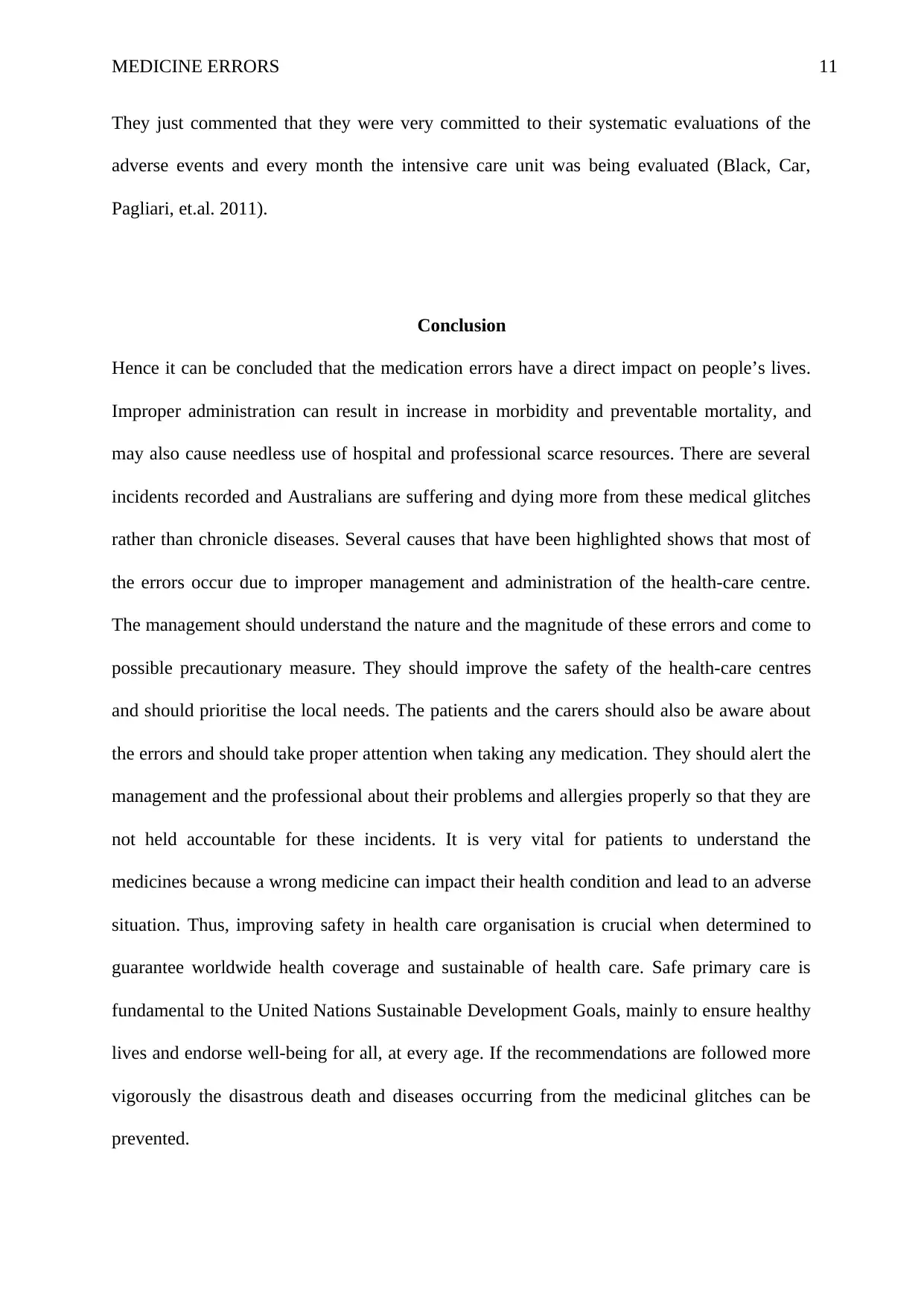
MEDICINE ERRORS 11
They just commented that they were very committed to their systematic evaluations of the
adverse events and every month the intensive care unit was being evaluated (Black, Car,
Pagliari, et.al. 2011).
Conclusion
Hence it can be concluded that the medication errors have a direct impact on people’s lives.
Improper administration can result in increase in morbidity and preventable mortality, and
may also cause needless use of hospital and professional scarce resources. There are several
incidents recorded and Australians are suffering and dying more from these medical glitches
rather than chronicle diseases. Several causes that have been highlighted shows that most of
the errors occur due to improper management and administration of the health-care centre.
The management should understand the nature and the magnitude of these errors and come to
possible precautionary measure. They should improve the safety of the health-care centres
and should prioritise the local needs. The patients and the carers should also be aware about
the errors and should take proper attention when taking any medication. They should alert the
management and the professional about their problems and allergies properly so that they are
not held accountable for these incidents. It is very vital for patients to understand the
medicines because a wrong medicine can impact their health condition and lead to an adverse
situation. Thus, improving safety in health care organisation is crucial when determined to
guarantee worldwide health coverage and sustainable of health care. Safe primary care is
fundamental to the United Nations Sustainable Development Goals, mainly to ensure healthy
lives and endorse well-being for all, at every age. If the recommendations are followed more
vigorously the disastrous death and diseases occurring from the medicinal glitches can be
prevented.
They just commented that they were very committed to their systematic evaluations of the
adverse events and every month the intensive care unit was being evaluated (Black, Car,
Pagliari, et.al. 2011).
Conclusion
Hence it can be concluded that the medication errors have a direct impact on people’s lives.
Improper administration can result in increase in morbidity and preventable mortality, and
may also cause needless use of hospital and professional scarce resources. There are several
incidents recorded and Australians are suffering and dying more from these medical glitches
rather than chronicle diseases. Several causes that have been highlighted shows that most of
the errors occur due to improper management and administration of the health-care centre.
The management should understand the nature and the magnitude of these errors and come to
possible precautionary measure. They should improve the safety of the health-care centres
and should prioritise the local needs. The patients and the carers should also be aware about
the errors and should take proper attention when taking any medication. They should alert the
management and the professional about their problems and allergies properly so that they are
not held accountable for these incidents. It is very vital for patients to understand the
medicines because a wrong medicine can impact their health condition and lead to an adverse
situation. Thus, improving safety in health care organisation is crucial when determined to
guarantee worldwide health coverage and sustainable of health care. Safe primary care is
fundamental to the United Nations Sustainable Development Goals, mainly to ensure healthy
lives and endorse well-being for all, at every age. If the recommendations are followed more
vigorously the disastrous death and diseases occurring from the medicinal glitches can be
prevented.
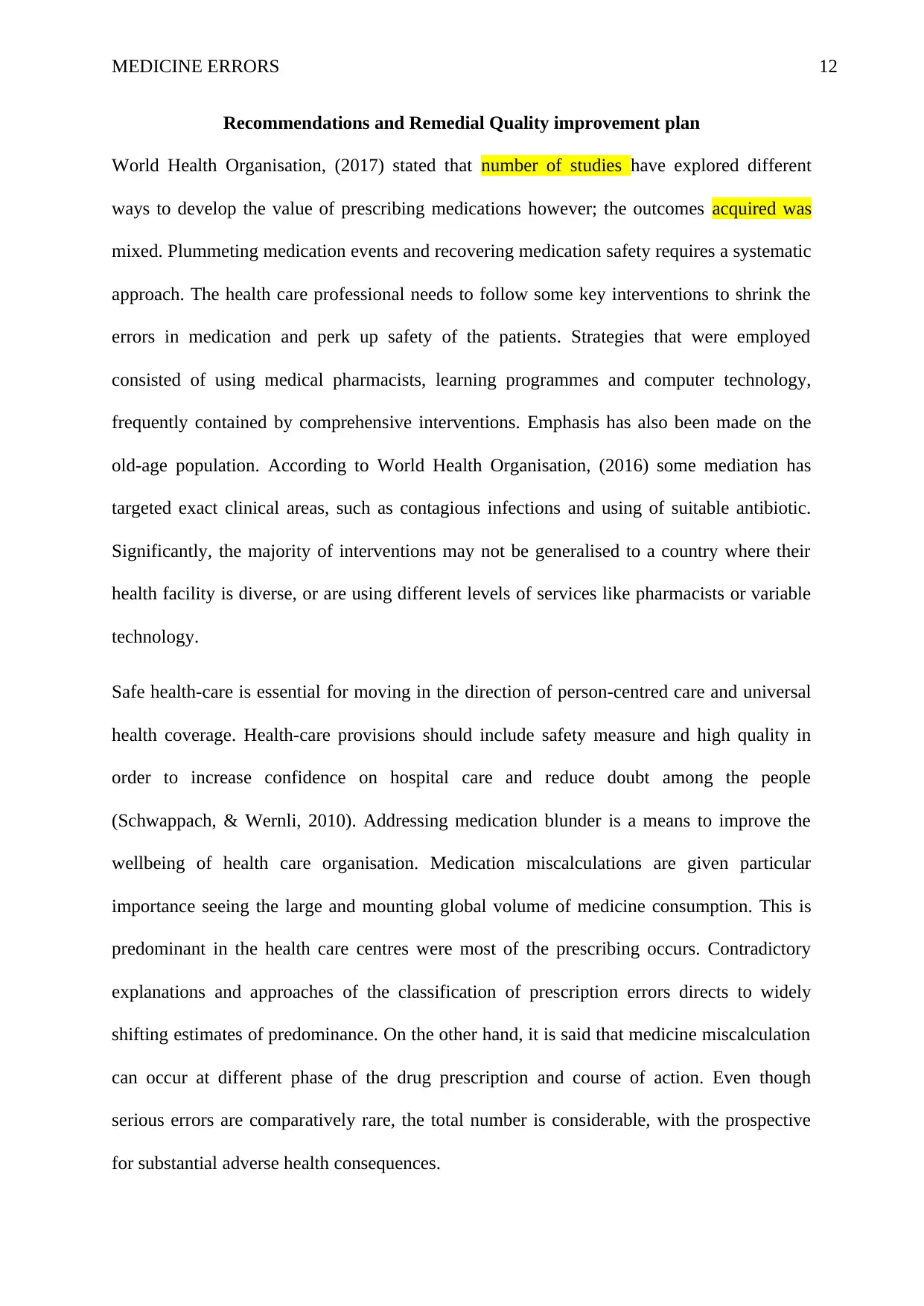
MEDICINE ERRORS 12
Recommendations and Remedial Quality improvement plan
World Health Organisation, (2017) stated that number of studies have explored different
ways to develop the value of prescribing medications however; the outcomes acquired was
mixed. Plummeting medication events and recovering medication safety requires a systematic
approach. The health care professional needs to follow some key interventions to shrink the
errors in medication and perk up safety of the patients. Strategies that were employed
consisted of using medical pharmacists, learning programmes and computer technology,
frequently contained by comprehensive interventions. Emphasis has also been made on the
old-age population. According to World Health Organisation, (2016) some mediation has
targeted exact clinical areas, such as contagious infections and using of suitable antibiotic.
Significantly, the majority of interventions may not be generalised to a country where their
health facility is diverse, or are using different levels of services like pharmacists or variable
technology.
Safe health-care is essential for moving in the direction of person-centred care and universal
health coverage. Health-care provisions should include safety measure and high quality in
order to increase confidence on hospital care and reduce doubt among the people
(Schwappach, & Wernli, 2010). Addressing medication blunder is a means to improve the
wellbeing of health care organisation. Medication miscalculations are given particular
importance seeing the large and mounting global volume of medicine consumption. This is
predominant in the health care centres were most of the prescribing occurs. Contradictory
explanations and approaches of the classification of prescription errors directs to widely
shifting estimates of predominance. On the other hand, it is said that medicine miscalculation
can occur at different phase of the drug prescription and course of action. Even though
serious errors are comparatively rare, the total number is considerable, with the prospective
for substantial adverse health consequences.
Recommendations and Remedial Quality improvement plan
World Health Organisation, (2017) stated that number of studies have explored different
ways to develop the value of prescribing medications however; the outcomes acquired was
mixed. Plummeting medication events and recovering medication safety requires a systematic
approach. The health care professional needs to follow some key interventions to shrink the
errors in medication and perk up safety of the patients. Strategies that were employed
consisted of using medical pharmacists, learning programmes and computer technology,
frequently contained by comprehensive interventions. Emphasis has also been made on the
old-age population. According to World Health Organisation, (2016) some mediation has
targeted exact clinical areas, such as contagious infections and using of suitable antibiotic.
Significantly, the majority of interventions may not be generalised to a country where their
health facility is diverse, or are using different levels of services like pharmacists or variable
technology.
Safe health-care is essential for moving in the direction of person-centred care and universal
health coverage. Health-care provisions should include safety measure and high quality in
order to increase confidence on hospital care and reduce doubt among the people
(Schwappach, & Wernli, 2010). Addressing medication blunder is a means to improve the
wellbeing of health care organisation. Medication miscalculations are given particular
importance seeing the large and mounting global volume of medicine consumption. This is
predominant in the health care centres were most of the prescribing occurs. Contradictory
explanations and approaches of the classification of prescription errors directs to widely
shifting estimates of predominance. On the other hand, it is said that medicine miscalculation
can occur at different phase of the drug prescription and course of action. Even though
serious errors are comparatively rare, the total number is considerable, with the prospective
for substantial adverse health consequences.
⊘ This is a preview!⊘
Do you want full access?
Subscribe today to unlock all pages.

Trusted by 1+ million students worldwide
1 out of 17
Related Documents
Your All-in-One AI-Powered Toolkit for Academic Success.
+13062052269
info@desklib.com
Available 24*7 on WhatsApp / Email
![[object Object]](/_next/static/media/star-bottom.7253800d.svg)
Unlock your academic potential
Copyright © 2020–2025 A2Z Services. All Rights Reserved. Developed and managed by ZUCOL.





